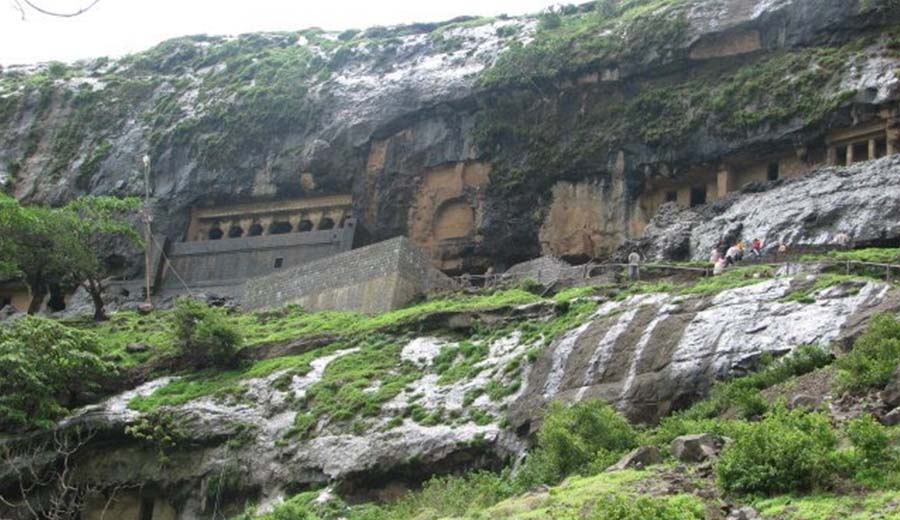Lenyadri Caves
Come Visit the Lenyadri – The Land of Devotees
Lenyadri, also known as the Ganesha Lena, is a 30-rock-cut Buddhist cave, situated at a distance of about 5km north of Junnar in the Pune district in the Indian state of Maharashtra. Other caves surrounding the Junnar city are Manmodicaves, Shivneri caves, and Tulja caves.
One of the caves which originally happened to be a Buddhist Vihara has been adapted at a later stage as a Hindu temple dedicated to the god Ganesha. It is one of the Ashtavinayak shrines located in Western Maharashtra. There lie exactly twenty-six of the caves which are individually numbered. The caves face the south and are numbered serially from east to west. Of the many caves present, 9 of them are Chaitya-grihas or chapels, while the rest are viharas or monasteries. The latter is in the form of dwellings and cells. There are also several rock-cut water cisterns out of which two of them have inscriptions. The caves can be dated from between the 1st and 3rd century AD while the Ganesha shrine belongs to the 1st century AD.
Architecture of Lenyadri
The Asthavinayaka shrine is one of the largest excavations of Junnar, of about 100 feet which is approximately 30 m above sea level. In design, it is an unpillared hall with 20 rooms approximately of different dimensions. The hall is large and can be entered by a central door, under a veranda supported only with pillars with 2 windows on either side of the entrance. The hall, in recent days, is treated as the sabha-mandapa or the “assembly hall” of the Ganesha temple. 283 steps built in stone masonry over eight flights lead to the entrance. The steps are believed to represent sensual pleasures, which the god Ganesha has overcome. The veranda of the said vihara has six pillars and two pilasters (half-pillars), to support an architrave from which projects eaves relieved with a railing resting on beams and rafters.
Much later, the two central cells of the rear wall have been joined together by breaking the partition in between to place the Ganesha image. The old narrow entrance was widened during the conversion of the cells to the Ganesha temple. Two other smaller entrances to the hall are also an eye-catcher. All the entrances bear marks of sockets for fixing wooden doors during the conversion, and still, they do have doors. The paintings depicted Ganesha’s childhood, marriage preparations, battle with demons, and much more. Some of the cells which were used for storage were locked with wooden doors. Nine memorials resembling Sati were added on the left wall during the construction, each in the shape of a long pillar with an arched top, and to the right of each pillar, a hand raised above the elbow, with an open palm, signifying Sati’s blessing. While three panels were plain, the rest was sculpted to make memorials.
10 Places to visit around Lenyadri caves
Junnar Caves:
Junnar Caves are a group of over 200 rock-cut caves located near Lenyadri that date back to the 2nd century BCE. These caves are known for their ancient Buddhist rock-cut architecture and are a popular tourist destination for history and archaeology enthusiasts. The caves consist of chaitya halls, viharas, and rock-cut sculptures, and provide a glimpse into the ancient Buddhist civilization of India.
Bhimashankar Temple:
Bhimashankar Temple is a revered Jyotirlinga temple dedicated to Lord Shiva, located in the Bhimashankar Wildlife Sanctuary. This temple is known for its architectural beauty and historical significance and attracts thousands of pilgrims every year. The temple is surrounded by scenic hills and forests and is a popular destination for trekking and nature lovers.
Malshej Ghat:
Malshej Ghat is a scenic mountain pass in the Western Ghats, known for its waterfalls, hill stations, and trekking trails. This region is a popular destination for adventure and nature enthusiasts, who come here to enjoy its scenic beauty and challenging treks. The ghat is surrounded by lush green forests and is home to a diverse array of flora and fauna.
Shri Girijatmaj Temple:
Shri Girijatmaj Temple is a temple dedicated to Lord Ganesha, located near Lenyadri and known for its ancient rock-cut architecture. This temple is believed to have been built during the 8th century and is one of the oldest rock-cut temples in India. The temple is famous for its intricate carvings and sculptures and attracts a large number of pilgrims and tourists every year.
Ozar:
Ozar is a small village located near Lenyadri that is famous for its ancient Vishnu temple and its association with the legendary Maratha warrior, Chhatrapati Shivaji. The village is surrounded by lush green forests and hills and is a popular destination for nature lovers. The temple is known for its architectural beauty and historical significance and attracts a large number of pilgrims every year.
Rajmachi Fort:
Rajmachi Fort is an ancient fort located near Lenyadri, known for its scenic views and historical significance. This fort was built during the 17th century and is an important landmark in the region’s history. The fort is surrounded by lush green forests and is a popular destination for trekking and adventure enthusiasts. The fort provides panoramic views of the surrounding hills and forests, making it a popular spot for tourists and photographers.
Lenyadri Caves:
Lenyadri Caves are a group of 30 rock-cut Buddhist caves located near Junnar, Maharashtra. These caves date back to the 1st century BCE and are known for their intricate rock-cut sculptures and carvings. The caves are considered to be one of the oldest Buddhist rock-cut cave temples in India and are a popular tourist destination for history and archaeology enthusiasts. Lenyadri Caves are also considered to be one of the Ashtavinayaka Temples, a group of eight revered Ganesha temples in the region.
Lenyadri Hill:
Lenyadri Hill is a hill located near Lenyadri and is known for its scenic beauty and historical significance. The hill is home to the Lenyadri Caves and is considered to be a sacred site by Buddhists, Hindus, and Jains. The hill is surrounded by lush green forests and is a popular destination for trekking and nature enthusiasts. Visitors can enjoy panoramic views of the surrounding hills and forests from the top of the hill.
Narayanpur Dam:
Narayanpur Dam is a dam located near Lenyadri and is known for its scenic beauty and recreational facilities. The dam provides water to the surrounding regions and is also a popular destination for picnics and boating. Visitors can enjoy scenic views of the surrounding hills and forests and can also go boating on the calm waters of the dam. The dam is surrounded by lush green forests and is a popular destination for nature lovers.
Jivdhan Fort:

Jivdhan Fort is an ancient fort located near Lenyadri and is known for its scenic beauty and historical significance. The fort was built during the 17th century and is an important landmark in the region’s history. The fort is surrounded by lush green forests and is a popular destination for trekking and adventure enthusiasts. Visitors can enjoy panoramic views of the surrounding hills and forests from the top of the fort.
How to reach Lenyadri
Lenyadri is located near Junnar in Maharashtra, India, and can be reached by the following modes of transportation:
- By Air: The nearest airport to Lenyadri is the Pune International Airport, which is approximately 120 km away. From the airport, you can take a taxi or a bus to reach Lenyadri.
- By Train: The nearest railway station to Lenyadri is the Junnar Railway Station, which is approximately 7 km away. From the railway station, you can take a taxi or a local bus to reach Lenyadri.
- By Road: Lenyadri is well-connected by road and is accessible by bus or taxi from major cities in the region such as Pune, Mumbai, and Nashik. State-run buses and private taxis are easily available from these cities to reach Lenyadri.
It is advisable to plan your trip in advance and make all necessary arrangements to ensure a smooth and comfortable journey to Lenyadri.
Best time to visit
The best time to visit Lenyadri is between October and March, during the winter months. During this time, the weather is pleasant with clear skies, making it ideal for sightseeing and outdoor activities. The monsoon season, which lasts from June to September, can make the area difficult to access and dampen the experience for visitors. The summer months of April to June can get quite hot and humid, making it challenging for outdoor activities.
Visiting Lenyadri during the winter months will provide the best weather conditions for visiting the Lenyadri Caves, Lenyadri Hill, Narayanpur Dam, and Jivdhan Fort. Additionally, several festivals and cultural events are held in the region during this time, providing visitors with a unique opportunity to experience the local culture and traditions.



